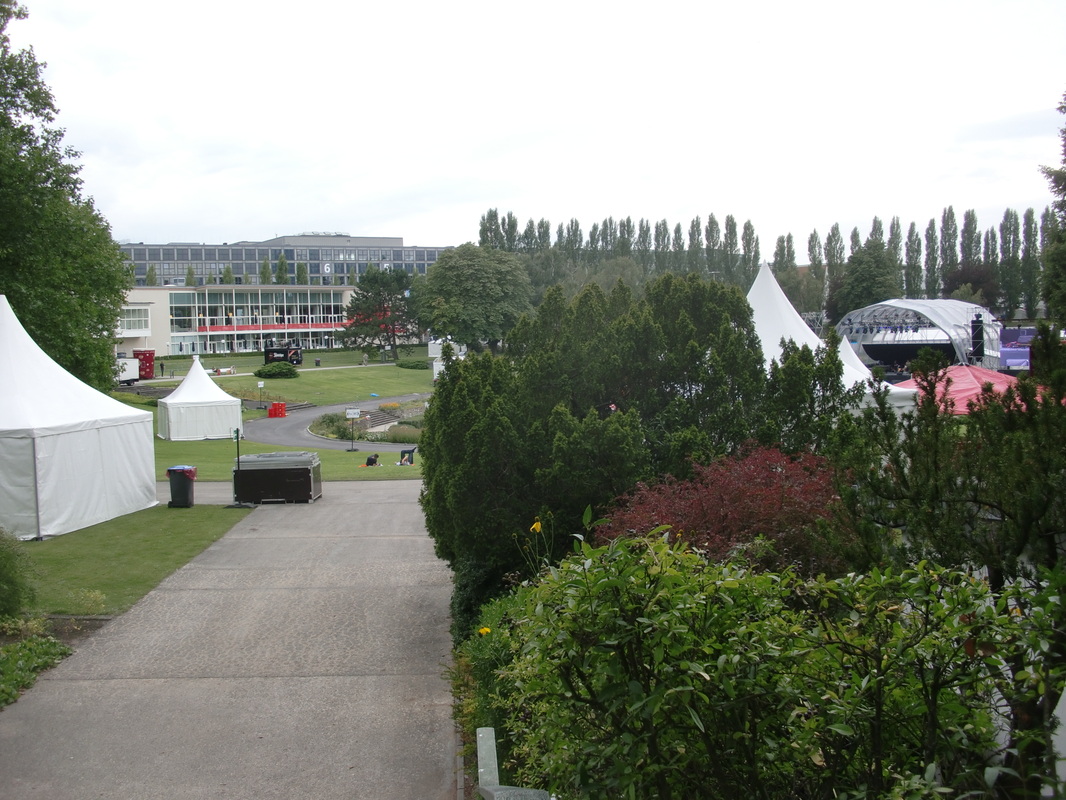|
Kultur shock returns. After almost two decades of going to the Consumer Electronics Show in Las Vegas, last year I attended the IFA Berlin tech trade show for the first time. And it’s that time of year again, so here I am again on the ICC Messe Berlin Fairgrounds, 27 buildings spread out across a huge tract of land. All mixed together with tents and booths and music (all that’s missing are jugglers and mimes, though I don’t put it past them to show up), it’s a decided circus atmosphere. IFA Berlin is the old veteran compared to the upstart CES, having been around for 89 years (not shockingly, it was very different then, centered around radios). And they have their set way of doing things. This notably includes that, unlike CES, the IFA Berlin show opens its doors to the general public for a small fee. That’s when things truly turn into a circus.
For the moment, though, things are relatively peaceful, wandering through the gardens and attending pre-show press conferences. That’s another big difference – I tend to avoid such things, but at IFA press conferences take on added importance, since it’s a significant way to get information before the hordes break past the Brandenburg Gates. In many ways, IFA Berlin and CES are similar, surrounding you with the latest tech. But there are subtle, but clear differences. Last year, I described that difference as, “While January's CES tends to show the direction the tech industry is heading for the year, IFA Berlin gives a greater sense of innovation, providing a focus on what's developing and could be next.” As such, you tend to see a lot more home consumer electronics. Or "Unterhaltungselektronik," as we like to say. There are 1,500 exhibitors here, from 70 countries. And though the show hasn’t officially started yet, it has been possible to get a sense of some of what the world has brought here – from the press conferences, wandering, and always-wonderful Showstoppers event (which they put on around the world, bringing together select companies and the press in a far more low-key environment.) I’ll have a more in-depth look later on, once I see more and decompress, but even the starters are pretty overwhelming. On my morning, I went to a press conference from Miele (a German home appliance company like Siemens, Krupp and Bosch) because it seemed like it might be interesting. And I suspect it was quite interesting, except it was all in German, one of the many languages I don’t speak.From wandering around, though, I can tell you that they are coming out with a solar powered washing machine and a lot of espresso machines. (As I noted, IFA has been around for 89 years, and until about 10 years ago, it was exclusively a local German show. It’s expanded to be a major international tech trade extravaganza in only a decade, and they’ve done an impressive job expanding to that worldwide market. But remnants of the purely-German influence remains. And that’s fine, it’s their show, but since most of the world doesn’t speak German it can cause a few hiccups.) Bosch held their press conference in German, too, though they handed out headsets where an enthusiastic translator gave a play-by-play. Alas, as happens at so many press conferences anywhere in the world, they largely talked about “markets” and “goals” and “Our Vision,” and also how last year visitors to their booth voted for lime-green to be their color of choice for a refrigerator, which sort of surprised everyone. That aside, Bosch, too, has a lot of espresso machines (as you might have guessed, these are big at IFA), but also had some incredibly quiet dryers, lots of smart irons (hey, if it was really smart, it wouldn't be an iron...) and an impressive line of cordless, powerful, quiet vacuum cleaners. (As part of this exhibit, they were running the company's very funny TV ad for the appliance, which centered out a test scientist who had to try out the vacuum next to a sleeping tiger.) One of the big “buzzes” here is about SmartWatches – it’s a big, new product field with Samsung getting into the fray, joining Apple and Google, and some lesser-known folks. I don't dismiss the technology, but I do scratch my head about what they see as the big market for this. I've seen SmartWatches demonstrated in the past, and they've struck me as a big yawn. First of all, everything they do, cell phones do already, and most people have a cell phone – which, mind you, have far bigger screens than SmartWatches do. And secondly, as others in the press I’ve spoken to have noted -- how many people do you know who use watches much anymore?? Clearly, yes, many do -- but people today seem to just check their cell phone for the time. I spoke with a few people who saw Samsung’s demo of its Galaxy Gear SmartWatch. They came away deeply uncertain. The watch was thick, heavy and its battery life is reported to be one day (though one wonders if heavy use will drain that more quickly), and the retail price is $300, which will eventually drop. But even without those question marks, there remains the other question, is there a market? Clearly the companies think so. And sometimes they’re right. And sometimes they make 3D TVs with glasses. So...while perhaps there's a big market for this -- at the moment until convinced otherwise, I wait to be convinced. Though the show hasn’t officially opened yet, I did get to see some products. I’ve been impressed by two very thin, very light convertible Window 8 ultralights – the Sony Vaio Tab and the Lenovo Yoga line. (Convertibles can switch from a notebook to a tablet. The Lenovos additionally twist and allow for different configurations, such as a stand.) Sony also had a new Smartphone, the Xperia Z, which had some serious photo capabilities, and also introduced the high-end Cybershot QX10 (and 100) – an attachment onto your Smartphone that turns it into a high-end camera lens system. While made for the Sony Xperia, an adapater will allow it to work on most Smartphones. And then at the always wonderful event run by the Showstoppers group at many trade shows around the world, there was a sneak preview of a wide range of all things tech. Nothing that will change the marketplace (as in "Did you see anything cool?!"), but several improvement that help the way you do things, which is what I often categorize as "coo." For instance, one my favorite companies, X-Mini has released two new speakers in their line of tiny "golf ball-sized," high quality, but low-cost portable speakers. The Uno and the stereo two-speaker Max now have ceramic drivers that make for especially crisp and powerful booming sound for devices that can fit in your pocket and only cost $30 and $40 respectively. Also in audio, Beydynamic has come up with a brain-dead simple idea that's so smart. Their DX 120 and 160 earbuds have detachable cords, allowing you to exchange a long cord for a short one when you need it. Earlier I mentioned Sony's camera lens attachment for their Smartphone than has an adapter for other brands. A similar product is available from Olloclip. These are only for the iPod and iPod touch, but have a very smart twist. As noted with these kinds of lens add-ons, they often won't work when a camera is in a case. And so, it can be cumbersome to remove you phone case every time you want to use the camera lenses. What Olloclip developed is a case for your iPhone or iPod touch that has a slot for any one of their three lenses. As a result, there's no need to remove your case to use the add-on lenses. (The company makes three: a wide-angle, a macro (for extreme close-ups) and a telephoto.) And finally, Toshiba has entered the convertible PC field with their 13.3" Satellite Click. What's unique is that they conceived the device first as a full PC and rather than slide or fold the screen to create a tablet, you can completely remove the table with one simple click. At that point you have a 13" standalone tablet. It's a bit heavier and thick than the aforementioned Sony and Lenovos, and battery life on the tablet is a little low on the tablet (because they split it in two, so save on space and weight), at five hours, but an impressive 10 hours when the tablet and computer are connected. Most respectable of all is that it should only cost about $650 when it's soon released in the U.S. That's it for now. Keep in mind that IFA Berlin hasn't even officially opened yet, so these are just some quick observation. But there is innovation ahead, when the doors open tomorrow, Friday. I'll have a complete report of the full IFA coming soon.
0 Comments
Leave a Reply. |
AuthorRobert J. Elisberg is a political commentator, screenwriter, novelist, tech writer and also some other things that I just tend to keep forgetting. Feedspot Badge of Honor
Archives
June 2024
Categories
All
|
|
© Copyright Robert J. Elisberg 2024
|







 RSS Feed
RSS Feed